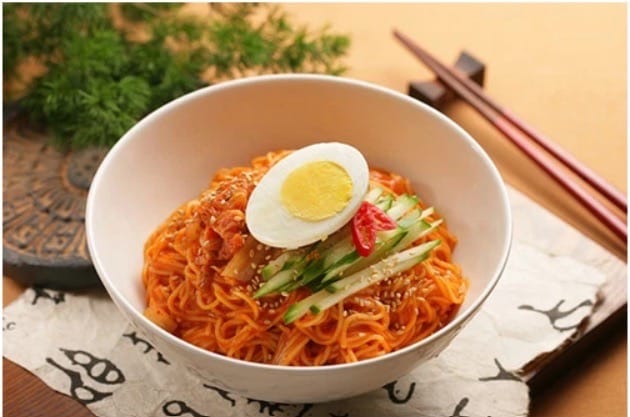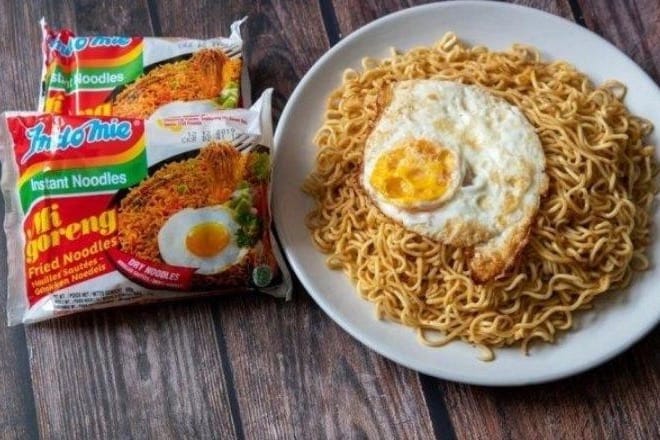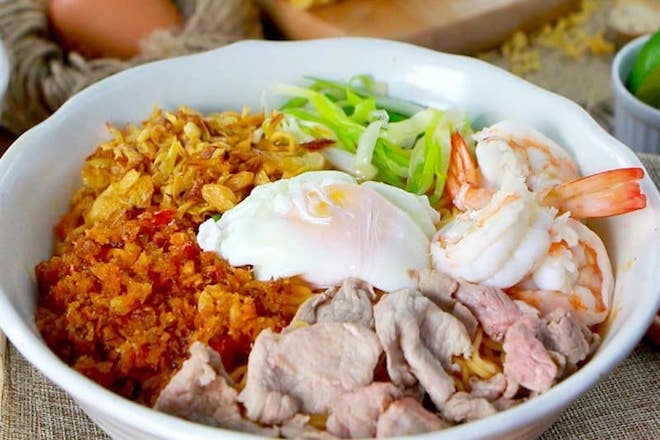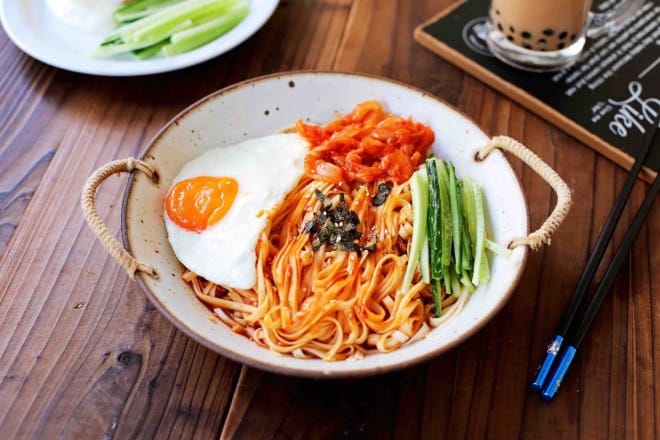Dry noodles Vietnamese, cherished for their delectable sweet and sour flavors and fresh toppings, are a culinary gem worth trying. Join us in this article as we guide you through the tastes and recipes of this beloved dish.
Contents
What are Dry Noodles Vietnamese? (Mì Khô or Mì Trộn Khô)
Vietnamese dry noodles, often referred to as “mì khô” or “mì trộn khô,” hold a special place in Vietnamese cuisine. They are characterized by a distinctive ingredient combination that creates a harmonious flavor profile.
- Noodles: The foundation of Vietnamese dry noodles is typically or egg noodles. These noodles are prepared to achieve a pleasing, slightly chewy texture.
- Sweet and Sour Sauce: A defining feature of this dish is the sweet and sour sauce poured generously over the noodles. This sauce, a blend of sugar, fish sauce, lime, and chili, creates a delicious balance of flavors.
- Fresh Toppings: Vietnamese dry noodles are adorned with an assortment of fresh toppings, including bean sprouts, herbs, peanuts, fried shallots, and occasionally grilled meats such as pork or shrimp. These toppings provide a burst of freshness and complexity to the dish.

Eggs Are The Most Popular Topping In Dry Noodles – Source: Internet
Vietnamese dry noodles are a culinary gem well worth exploring. They offer a delightful interplay of sweet, sour, and savory flavors, making them a memorable part of Vietnamese gastronomy. Whether you are a food enthusiast or a traveler seeking to savor Vietnamese culture, this dish is a culinary adventure you will want to experience.
Tasting authentic Pho types in Vietnam will create a memorable culinary experience.
Preparing Dry Noodles Vietnamese (Mì Trộn)
Vietnamese dry noodles, or “mì trộn”, are a culinary delight that captures the essence of Vietnamese flavors. In this section, we’ll explore the art of preparing these quintessential dishes, providing step-by-step instructions for a delectable dish.
Step-by-Step Instructions for Preparing “Mì Trộn” with Shrimp
There are two ways to make Vietnamese dry noodles: using instant noodles or home cooking. This recipe uses egg noodles for an authentic experience. If using instant noodles, follow the package instructions and proceed with the recipe.

Let’s delve into the preparation of a popular Vietnamese dry noodle dish, “mì trộn,” which features shrimp as the protein. Here’s a step-by-step guide to recreate this delightful meal at home.
Ingredients (Serves 2):
- 200g of egg noodles
- 2 eggs
- 200g of fresh shrimp, peeled and deveined
- 1 cup of fresh bean sprouts
- A handful of fresh herbs (e.g., mint, coriander)
- 2 tablespoons of crushed peanuts
- 2 tablespoons of fried shallots
- Lime wedges for garnish
For the Sweet and Sour Sauce:
- 2 tablespoons of sugar
- 2 tablespoons of fish sauce
- 2 tablespoons of lime juice
- 1-2 cloves of garlic, minced
- 1-2 red chilies, finely chopped (adjust to your spice preference)
Instructions:
- Cook the Noodles: Boil the egg noodles according to the package instructions until they are tender but still slightly firm. Drain and rinse them with cold water to stop the cooking process. Set them aside.
- Prepare the Sweet and Sour Sauce: In a bowl, mix sugar, soy sauce, lime juice, minced garlic, and spicy chilli sauce. Adjust the sweetness, saltiness, and spiciness to your liking.
- Cook the Eggs: In a non-stick pan, scramble the eggs until they are cooked but still moist. Remove from heat.
- Cook the Shrimp: In the same pan, add a bit of oil and sauté the shrimp until they turn pink and are cooked through. This should take 2-3 minutes. Remove from heat.
- Assemble the Dish: Divide the cooked noodles into two serving bowls. Top them with the scrambled eggs, cooked shrimp, fresh bean sprouts, and herbs. You can also add sausage as a topping.
- Sauce It Up: Drizzle the sweet and sour sauce generously over the noodles.
- Add Toppings: Mix together with chives, blanched bok choy and bean sprouts.
- Garnish with Lime: Serve with lime wedges on the side for those who prefer an extra zing.
In Vietnamese street food, you will also encounter variations of this noodle dish.
Etiquette and Tips for Enjoying
To fully appreciate your Vietnamese dry noodles, keep these etiquette and tips in mind:
- Mix Thoroughly: Use your chopsticks or fork to mix the ingredients, ensuring that the sauce coats every component evenly.
- Taste as You Go: Vietnamese dry noodles offer a symphony of flavors. Take a moment to savor the sweet, sour, and savory notes in each bite.
- Experiment with Toppings: Feel free to customize your dish with additional toppings like fresh chili, lime wedges, or hoisin sauce.
- Slurping Is Acceptable: In Vietnamese culture, slurping your noodles is not considered impolite. It’s a sign that you’re enjoying your meal.
- Pair with Fresh Herbs: Add extra herbs for a burst of freshness and aroma, enhancing the overall experience.

Dry Noodle Vietnamese Is Mixed With Many Toppings – Source: Internet
Nutritional Information of Mì Trộn
Let’s explore the nutritional aspects of this dish, along with calorie counts and dietary considerations, especially for travelers who are health-conscious.
Examining the Nutritional Aspects of Vietnamese Dry Noodle Dishes
Vietnamese dry noodles are renowned for their sensory appeal, but for those interested in their nutritional content, it’s crucial to understand the components that contribute to this dish’s nutrition:
- Egg Noodles: The fundamental component, egg noodles, provides carbohydrates, a source of energy and dietary fiber important for digestion.
- Protein: Commonly featuring protein sources like grilled pork or shrimp, this dish offers essential protein for muscle health and overall well-being.
- Fresh Vegetables: Toppings such as bean sprouts and herbs introduce an array of vitamins, minerals, and dietary fiber, enhancing the dish’s nutritional value.
- Sweet and Sour Sauce: While adding flavor, this sauce can be relatively high in sugar and sodium. It’s advisable to use it in moderation.
Calorie Counts and Dietary Considerations for Health-Conscious Travelers
Understanding the nutritional dimensions of Vietnamese dry noodles is essential for health-conscious travelers and those watching their calorie intake. Here’s a brief overview of calorie counts and dietary considerations.

- Calories: The calorie content of a typical serving can vary based on the ingredients used. A serving typically falls within the range of 400 to 600 calories. Meat and shrimp offer lean protein but it can add to the calorie count.
- Protein: Including sausage or shrimp supplies a notable protein content, making it a suitable choice for those aiming to maintain their muscle health while enjoying a flavorful meal.
- Carbohydrates: The noodles are the primary carbohydrate source, providing energy. Individuals on low-carb diets might want to reduce noodle portions or explore alternative options.
- Fiber: The presence of fresh vegetables means a higher fiber content, which aids in digestion and provides a sense of fullness.
- Sugar and Sodium: The sweet and sour sauce may contain significant sugar and sodium levels, and health-conscious travelers should consider using the sauce judiciously or requesting it separately.
- Dietary Restrictions: For travelers with specific dietary restrictions, like vegetarians or vegans, it’s possible to adapt the dish by omitting meat and ensuring the sauce is free from animal-derived ingredients.
Note: This dish is not healthy; you may opt for other healthy food choices.
Conclusion
From recipes to cultural insights, Vietnamese dry noodles offer a flavorful journey into the heart of Vietnam’s culinary heritage. This article serves as a comprehensive guide for tourists, providing an understanding of dry noodles’ significance, along with recipes, restaurant recommendations, and nutritional information. Explore Vietnam’s rich culture one delicious bowl at a time.


Related Posts
Saigon’s “Flower Market Replica”: Where To Find Them
Ho Chi Minh City’s floral charm is not limited to its bustling wholesale markets. Imagine wandering through a place where vibrant petals, fragrant blooms, and the spirit of traditional Vietnamese markets come alive—without the overwhelming crowds. A flower market replica captures that magic, blending the beauty of fresh flowers with the charm of a curated, […]
Is it Safe to Travel to Vietnam Right Now? A Complete 2025 Guide
Vietnam has emerged as one of Southeast Asia’s most captivating destinations, drawing millions of visitors annually with its rich culture, stunning landscapes, and incredible cuisine. However, many travelers still ask: Is it safe to travel to Vietnam right now? This comprehensive guide provides you with everything you need to know about Vietnam travel safety in […]
Ho Chi Minh Cu Chi Tunnels Tour: The Ultimate Guide
The Cu Chi Tunnels stand as one of Vietnam’s most remarkable historical sites, offering visitors a profound glimpse into the ingenuity and resilience displayed during the Vietnam War. For travelers, a Ho Chi Minh Cu Chi tunnels tour represents an essential experience that combines education, adventure, and deep cultural understanding. This comprehensive guide will help […]